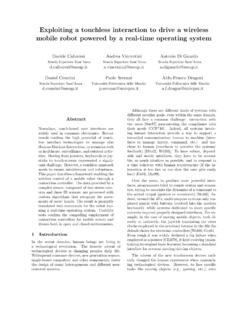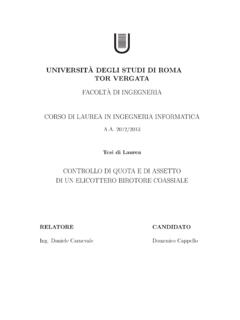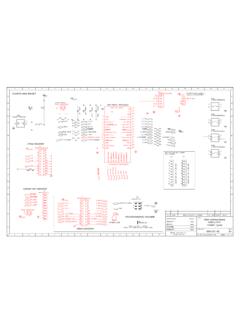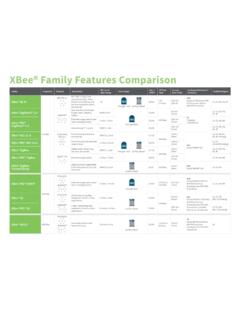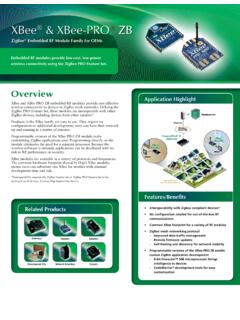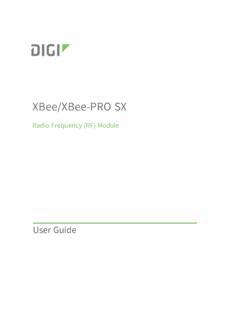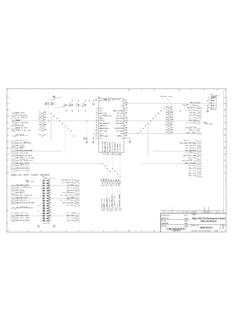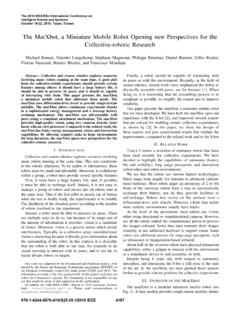Transcription of Waspmote-LoRa-868MHz 915MHz-SX1272 - Libelium
1 waspmote -LoRa-868 MHz_915 MHz- sx1272 Networking IndexDocument Version: - 02/2017 Libelium Comunicaciones Distribuidas LoRa and LoRaWAN ..42. Hardware ..53. Dual radio with Expansion Board .. Expansion Radio Board ..104. General considerations .. waspmote libraries .. waspmote sx1272 files .. Constructor .. API functions .. Additional functions .. Getting temperature .. Getting maximum allowed current supply .. waspmote reboot ..155. Transmission modes .. LoRaTM mode .. Bandwidth .. Coding Rate .. Spreading Factor ..176. Initialization .. Setting on .. Setting off ..187. Node parameters .. Node address .. Frequency band .. Packet parameters .. Structure used in packets .. Maximum payload ..229. Power gain and sensitivity .. Power level .. RSSI of one packet and RSSI of the channel.
2 SNR .. Index10. Long range tests .. Line of Sight test .. Non Line of Sight tests .. Tests in Zaragoza .. Test in Paris ..2811. Connectivity .. Topologies .. Connections .. Unicast .. Broadcast .. Connection parameters .. Setting retries .. Sending process .. sx1272 API packet structure .. Using Frame class to create sx1272 packets .. Sending data .. Receiving data .. How to receive packets in waspmote .. How to show received Frames .. Receiving all packets ..3612. Starting a network .. Choosing a channel .. Choosing a mode ..3713. Joining an existing network .. Channel .. Mode ..3814. Security and data encryption .. Security in transmissions ..3915. Understanding LoRa .. Introduction .. Long Range VS Transmission time / consumption .. LoRa VS xbee 868/900 MHz .. For what applications is LoRa a good option?
3 For what applications is NOT LoRa a good option? ..4316. Code examples and extended information ..4417. API changelog ..4618. Certifications .. and LoRaWAN1. LoRa and LoRaWANThis guide explains the LoRa features and functions. There are no great variations in this library for our new product lines waspmote v15 and Plug & Sense! v15, released on October 2016. Anyway, if you are using previous versions of our products, please use the corresponding guides, available on our Development website. You can get more information about the generation change on the document New generation of Libelium product lines . Libelium currently offers two options of this type of radio technology: LoRa and LoRaWAN LoRa contains only the link layer protocol and is perfect to be used in P2P communications between nodes.
4 LoRa modules are a little cheaper that the LoRaWAN ones. LoRaWAN includes the network layer too so it is possible to send the information to any Base Station already connected to a Cloud platform. LoRaWAN modules may work in different frequencies by just connecting the right antenna to its socket. These modules are based on the same modulation technology (the same PHY layer): LoRa , developed by Semtech. The LoRa module implements a simple link protocol, created by Libelium . However, the LoRaWAN module runs the LoRaWAN protocol, a much richer and more advanced protocol, created by the LoRa Alliance. The LoRa module and the LoRaWAN module are not compatible because the protocols are different. This guide talks about the LoRa module, not about LoRaWAN. If you are interested in the LoRaWAN module, please read the LoRaWAN Networking Guide: HardwareThe sx1272 chipset has been developed by the company Semtech.
5 Based on this chipset, Libelium created the waspmote -compliant LoRa module (or sx1272 module).Module Dual frequency bandTransmission powerSensitivityChannelsDistanceSX127286 3-870 MHz (Europe)14 dBm-134 dBm822+ km( + miles)902-928 MHz (US)13 Figure: LoRa moduleFigure: LoRa module with dBi user must keep in mind that there are two different antennas for LoRa modules regarding the frequency band: 868 or 900 MHz. Although the appearance of these antennas is the same, the user must choose which one needs to be purchased. Note: It is not recommended to work without an antenna screwed to the module. The module could be damaged due to RF reflections. The frequency used in Europe is the free ISM band of 868 MHz, using 8 channels with a bandwidth of MHz per channel. That is shown in the following : Frequency channels in the 868 MHz bandNote: These channels were chosen arbitrarily, according to the UN-111 appeared in the Spanish BOE-A-2013-4845.
6 If necessary, users can select the appropriate channels according to their country regulations. The frequency used in USA, Canada, Australia, Singapore or Israel is the free ISM band of 900 MHz, using 13 channels with a bandwidth of MHz per channel. It is shown in the following : Frequency channels in the 900 MHz bandNote: These channels were chosen arbitrarily; they fit the channels used by the equivalent xbee 900 MHz. If necessary, users can select the appropriate channels according to their country NumberCentral frequencyChannel NumberCentral MHzCH_16_868867 MHzCH_17_868868 MHzCH_12_900915 MHzFigure: Channels used by the LoRa modules in 868 MHz and 900 MHzNote: Due to the propagation characteristics of the 868/900 MHz bands, the near field effect could make that 2 modules cannot communicate if they are placed very close (< 1 m).
7 We suggest to keep a minimum distance of 3 or 4 meters between the energy section, the transmission power can be adjusted to several values:ParameterSX1272 power level'L'0 dBm'H'7 dBm'M'14 dBmFigure: Transmission power valueFigure: sx1272 output power LoRa module uses the SPI pins for communication. The SPI port allows more speed communication and frees up the waspmote s UART for other purposes. The Expansion Board allows to connect two communication modules at the same time in the waspmote sensor platform. This means a lot of different combinations are possible using any of the radios available for waspmote and the LoRa : LoRa module in Socket 0 Note: The sx1272 module can only be used in special waspmote v12 units which have been modified to drive the SPI pins to socket sx1272 module does not implement any security method.
8 Encryption is provided through the waspmote Encryption library. Specifically, through the AES algorithm with symmetric key, with a length of 128, 192 or 256 classic layout of this type of network is Star topology (shown in the figure), as the nodes establish point to point connections with brother nodes through the use of parameters such as the Node : Star topologyNote: OTA programming is not implemented for the LoRa module. Due to its low datarate, it would take much time to send one radio with Expansion Board3. Dual radio with Expansion Expansion Radio BoardThe Expansion Board allows to connect two communication modules at the same time in the waspmote sensor platform. This means a lot of different combinations are possible using any of the wireless radios available for waspmote : , ZigBee, DigiMesh, 868 MHz, 900 MHz, LoRa, WiFi, GPRS, GPRS+GPS, 3G, 4G, Sigfox, LoRaWAN, Bluetooth Pro, Bluetooth Low Energy and RFID/NFC.
9 Besides, the following Industrial Protocols modules are available: RS-485/Modbus, RS-232 Serial/Modbus and CAN Bus. Some of the possible combinations are: LoRaWAN - GPRS - Sigfox 868 MHz - RS-485 RS-232 - WiFi DigiMesh - 4G RS-232 - RFID/NFC WiFi - 3G CAN bus Bluetooth : GPRS, GPRS+GPS, 3G and 4G modules do not need the Expansion Board to be connected to waspmote . They can be plugged directly in the : waspmote with xbee radio on socket0 and Bluetooth Pro module on socket radio with Expansion BoardThe LoRa module can be used only in the socket 0. If the user wants to use a wireless radio, they must use the socket 1. WARNING: Avoid to use DIGITAL7 pin when working with Expansion Board. This pin is used for setting the xbee into sleep. Avoid to use DIGITAL6 pin when working with Expansion Board.
10 This pin is used as power supply for the Expansion Board. Incompatibility with Sensor Boards: -Agriculture v30 and Agriculture PRO v30: Incompatible with Watermark and solar radiation sensors -Events v30: Incompatible with interruption shift register -Gases v30: DIGITAL6 is incompatible with CO2 (SOCKET_2) and DIGITAL7 is incompatible with NO2 (SOCKET_3) -Smart Water v30: DIGITAL7 incompatible with conductivity sensor -Smart Water Ions v30: incompatible with ADC conversion -Gases PRO v30: Incompatible with SOCKET_2 y SOCKET_3 -Cities PRO v30: Incompatible with SOCKET_3. I2C bus can be used. No gas sensor can be considerations4. General waspmote waspmote sx1272 , is mandatory to include the sx1272 library when using this module. The following line must be introduced at the beginning of the code: #include < > ConstructorTo start using the waspmote sx1272 library, an object from class WaspSX1272 must be created.


